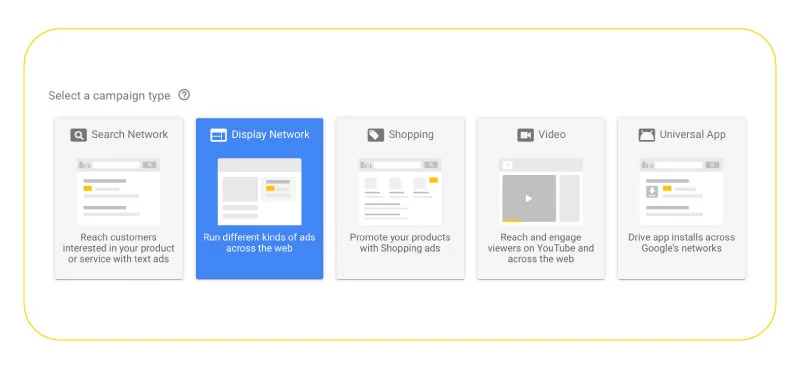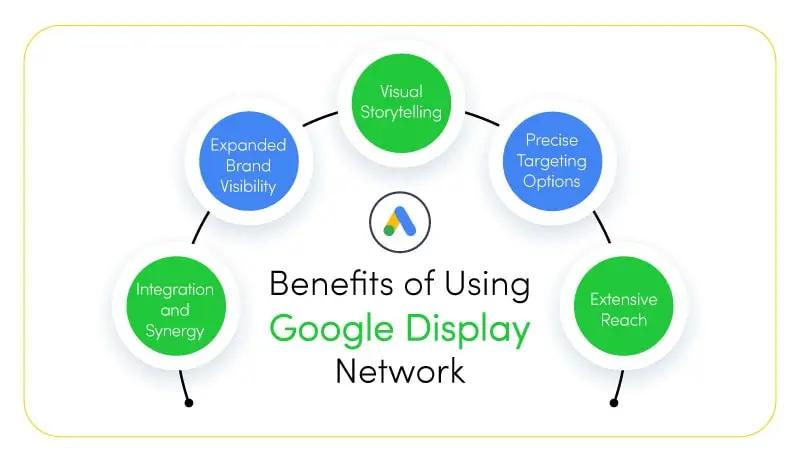In the expansive world of digital advertising, leveraging platforms that can significantly boost your brand’s visibility and impact is essential. That’s where the Google Display Network comes into play. Have you ever wondered, “What is Google Display Network?” or sought a clear Google Display Network definition? Look no further – this article will unravel the intricacies of the Google Display Network and illuminate its immense value for advertisers like yourself.
The Google Display Network is a dynamic ecosystem that offers a multitude of opportunities to connect with your target audience. It encompasses a vast network of websites, apps, and platforms where you can showcase your brand through visually captivating Google Display Ads. Unlike traditional text-based ads, Google Display Ads leverage the power of captivating images, engaging videos, and interactive formats to create a lasting impression on users as they navigate their favorite online destinations.

In this article, we will delve into what exactly the Google Display Network is, providing a comprehensive definition. We’ll explore the various formats of Google Display Ads and highlight the types of websites and platforms where these ads can appear, amplifying your brand’s visibility to a wide audience. Furthermore, we’ll uncover the significant benefits of leveraging the Google Display Network as a vital component of your advertising strategy, including advanced targeting options and unparalleled reach.
What is Google Display Network?
The Google Display Network is a powerhouse of digital advertising that opens up a world of opportunities for businesses seeking to expand their reach and engage with their target audience in a visually captivating manner. In simple terms, the Google Display Network can be defined as an extensive network of websites, mobile apps, and digital platforms where advertisers can showcase their brand through captivating and eye-catching Google Display Ads.
But what sets Google Display Ads apart from other forms of advertising? Unlike traditional text-based ads, Google Display Ads harness the power of visual storytelling to leave a lasting impression on users. They encompass a variety of formats, including compelling images, immersive videos, interactive experiences, and even engaging rich media ad formats. This versatility empowers advertisers to tailor their message and capture the attention of their audience in a way that resonates deeply.
Google Display Ads have the remarkable ability to reach users at various touchpoints throughout their online journey. They can appear on a diverse range of websites and platforms, including popular news sites, entertainment portals, niche blogs, and even mobile apps. This expansive reach ensures that your brand has the opportunity to connect with your target audience across different online destinations, enhancing your visibility and increasing the likelihood of driving meaningful engagement.

Moreover, the Google Display Network offers advanced targeting options that enable advertisers to precisely define and reach their desired audience segments. Whether it’s demographics, interests, browsing behavior, or even remarketing to previous visitors, the platform equips you with the tools to tailor your campaigns to specific user profiles. This level of granularity ensures that your ads are seen by the right people, enhancing the effectiveness of your advertising efforts and maximizing your return on investment.
In summary, the Google Display Network is a dynamic ecosystem that empowers businesses to captivate their audience through visually stunning Google Display Ads. It provides a wide array of ad formats, extensive reach across websites and apps, and advanced targeting options to help you deliver your message to the right people at the right time. So, get ready to unlock the immense potential of the Google Display Network and elevate your brand’s digital advertising game to new heights.
What Are the Benefits of Using Google Display Network?
When it comes to online advertising, the Google Display Network offers a plethora of benefits that set it apart from Google Search Ads. Let’s explore the advantages of leveraging the Google Display Network and understand how it complements your marketing strategy in the battle of Google Search vs Display Ads:
- Expanded Brand Visibility: While Google Search Ads target users actively seeking information, Google Display Ads take a different approach by expanding your brand’s visibility beyond search results. By appearing on a diverse network of websites, mobile apps, and digital platforms, your brand gains exposure to a vast audience base. This expanded reach helps you establish a stronger presence and increase brand awareness among potential customers.
- Visual Storytelling: Google Display Ads harness the power of visual storytelling to captivate your audience. Through eye-catching images, engaging videos, and interactive formats, you can convey your brand’s message in a more compelling and immersive way. These visually appealing ads have the potential to leave a lasting impression, creating a stronger connection with your target audience and enhancing engagement.
- Precise Targeting Options: The Google Display Network offers advanced targeting capabilities, allowing you to reach your desired audience with precision. With demographic targeting, you can tailor your ads based on factors such as age, gender, or location. Interest-based targeting enables you to connect with users who have shown a specific interest in relevant topics. By utilizing these targeting options, you can ensure that your ads are delivered to the most relevant audience segments, increasing the effectiveness of your campaigns.

- Extensive Reach: The Google Display Network boasts a massive reach, enabling you to connect with a vast number of potential customers. With millions of websites and apps participating in the network, your ads can appear across a diverse range of online destinations, reaching users in various niches and interests. This extensive reach allows you to tap into new markets, expand your customer base, and generate more opportunities for conversions.
- Integration and Synergy: The integration between Google Display Network and Google Ads provides a seamless experience for managing your advertising campaigns. By utilizing both Google Search Ads and Google Display Ads, you can create a cohesive marketing strategy that leverages the strengths of each platform. This synergy allows you to maximize the impact of your advertising efforts, achieve better overall campaign performance, and streamline your campaign management processes.
The Google Display Network brings unique benefits to the table. From expanded brand visibility and captivating visual storytelling to precise targeting options, extensive reach, and seamless integration with Google Ads, it provides a comprehensive solution for enhancing your online advertising initiatives. Embrace the power of the Google Display Network to gain a competitive edge and drive meaningful results for your business.
How Google Display Network Works
To truly harness the potential of the Google Display Network, it’s important to understand how it operates and how you can make the most of its features. In this section, we’ll dive into the inner workings of the network and explore the key elements that drive its functionality, including the auction process, targeting methods, and the types of Google Ads available.
- Auction Process and Bidding Strategies: The Google Display Network operates on an auction-based system, where advertisers compete for ad placement on websites and apps within the network. When a user visits a webpage or app, an ad space becomes available, triggering an instantaneous auction. During the auction, Google considers various factors, such as the bid amount, ad quality, and relevance to determine which ad will be displayed. It’s important to develop a well-defined bidding strategy to optimize your chances of winning the auctions and securing valuable ad placements.
- Targeting Methods: The Google Display Network offers a range of targeting methods to help you reach your desired audience. Firstly, contextual targeting analyzes the content of web pages and matches your ads to relevant themes or keywords. This ensures that your ads appear in the right context, increasing their effectiveness. Secondly, audience targeting allows you to focus on specific groups based on demographics, interests, or behaviors. By defining your target audience, you can tailor your ads to resonate with their preferences and increase the chances of engagement.

- Types of Google Ads: Within the Google Display Network, you can utilize various types of Google Ads to effectively engage your audience. Display Ads, the most common type, are visually compelling ads that appear on websites and apps. Responsive Display Ads automatically adjust their size, format, and appearance to fit different ad spaces, providing flexibility and optimal visibility. In addition, Gmail Ads appear within users’ Gmail inboxes, offering a unique opportunity to connect with them in a personalized and interactive manner. These diverse types of Google Ads cater to different advertising goals and provide ample opportunities for creative expression and engagement.
Understanding the inner workings of the Google Display Network equips you with the knowledge to optimize your campaigns and maximize your advertising impact. By developing effective bidding strategies, leveraging the various targeting methods, and utilizing the different types of Google Ads available, I can guarantee you can create compelling and highly targeted campaigns that resonate with your audience, driving increased visibility, engagement, and conversions.
Best Practices for Google Display Network
To achieve optimal results on the Google Display Network, it’s essential to implement effective strategies and follow industry best practices. In this section, we’ll explore key recommendations and actionable insights to help you create impactful Google Display Ads and develop a robust Google Display Ads strategy.
- Captivating Ad Designs: Design visually compelling and eye-catching ads that grab users’ attention. Use high-quality images or videos that align with your brand identity and evoke emotion. Ensure that your ad creative is clear, concise, and easy to understand. Experiment with different formats and variations to find what resonates best with your target audience.
- Clear Call-to-Action (CTA): Incorporate a clear and compelling CTA in your ads to encourage users to take the desired action. Whether it’s “Shop Now,” “Learn More,” or “Sign Up,” a strong CTA helps guide users towards the next step in their customer journey. Make your CTA stand out visually and position it strategically within your ad.
- Relevant Landing Pages: Drive users to landing pages that are highly relevant to the ad they clicked on. Ensure a seamless transition from ad to landing page by maintaining consistent messaging, design elements, and offers. Optimizing your landing pages for conversions and providing a clear path for users to complete desired actions can significantly impact your campaign’s success.
- Targeted Audience Segmentation: Utilize the targeting options available on the Google Display Network to segment your audience effectively. Define specific demographics, interests, or behaviors that align with your target market. This helps ensure that your ads reach the right people who are most likely to engage with your brand and convert.

- Remarketing Strategies: Implement remarketing strategies to re-engage users who have previously interacted with your website or shown interest in your products or services. Craft personalized ads that remind them of their previous engagement and entice them to return. Remarketing can be a powerful tool for driving conversions and increasing brand recall.
- Continuous Testing and Optimization: Continuously test and optimize your Google Display Ads to improve performance. Experiment with different ad variations, messaging, visuals, and targeting options. Monitor key metrics such as click-through rates (CTRs), conversion rates, and cost per conversion. Use this data to refine your campaigns, identify areas for improvement, and allocate budgets effectively.
- Monitor and Refine Placement Performance: Regularly review the performance of ad placements on the Google Display Network. Identify websites, apps, or placements that consistently deliver strong results and consider allocating more budget to them. Conversely, exclude underperforming placements to optimize your ad spend and focus on higher-performing avenues.
Developing a comprehensive Google Display Ads strategy involves a combination of creative design, targeted audience segmentation, and continuous optimization. By following these Google Display best practices, you can enhance the effectiveness of your campaigns, increase brand visibility, and drive meaningful results.
Conclusion
The Google Display Network plays a pivotal role in online advertising, providing businesses with a powerful platform to promote their brand and offerings. By understanding the definition of the Google Display Network and harnessing the capabilities of Google Display Ads, businesses can tap into a vast network of websites and apps to reach their target audience effectively. With its ability to combine visual appeal and precise targeting, the Google Display Network offers unparalleled opportunities for brand visibility, audience engagement, and marketing success in the digital landscape. Embracing the potential of the Google Display Network and leveraging the impact of Google Display Ads can propel businesses towards achieving their advertising goals and establishing a strong online presence.
FAQs
What is the Google Display Network (GDN)?
The Google Display Network (GDN) is a vast network of websites, apps, and digital platforms where advertisers can display their ads to a wide audience, expanding their brand visibility beyond search results.
How does the Google Display Network work?
The Google Display Network works through an auction-based system where advertisers bid for ad placement on participating websites and apps. When a user visits a webpage or app, an auction takes place to determine which ad will be displayed based on factors like bid amount, ad quality, and relevance.
What are the benefits of advertising on the Google Display Network?
Advertising on the Google Display Network offers several benefits, including expanded brand visibility, the power of visual storytelling through captivating ads, precise audience targeting options, extensive reach across diverse websites and apps, and seamless integration with Google Ads for streamlined campaign management.
What are the targeting options available on the Google Display Network?
The targeting options available on the Google Display Network include contextual targeting, which matches ads to relevant website content; audience targeting based on demographics, interests, and behaviors; and remarketing to engage users who have previously interacted with your brand. These options allow advertisers to tailor their ads to specific audience segments, increasing the effectiveness of their campaigns.







 Facebook Ads Spy Tool
Facebook Ads Spy Tool TikTok Ads Spy Tool
TikTok Ads Spy Tool